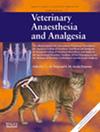Pharmacokinetics of combinations of dexmedetomidine, vatinoxan and ketamine in male neutered cats
IF 1.9
2区 农林科学
Q2 VETERINARY SCIENCES
引用次数: 0
Abstract
Objective
To characterize the pharmacokinetics of combinations of dexmedetomidine, vatinoxan and ketamine in cats.
Study design
Partially randomized, crossover, experimental study.
Animals
A group of six healthy male neutered cats, aged 1–2 years, weighing 5.4 ± 0.3 kg.
Methods
Each cat was administered six treatments: dexmedetomidine (25 μg kg–1; D) + vatinoxan (600 μg kg–1; V) + ketamine (2.5 mg kg–1; K2.5) intramuscularly (IM) (DVK2.5IM); D + V + ketamine (5 mg kg–1; K5) IM (DVK5IM); D + V + ketamine (10 mg kg–1; K10) IM (DVK10IM); D + K5 IM (DK5IM); D + V + K5 subcutaneously (SC) (DVK5SC); or D + V + K5 intravenously (IV) (DVK5IV). Venous blood samples were collected before treatment injection, and at various times up to 6 hours thereafter. Plasma dexmedetomidine, vatinoxan and ketamine concentrations were measured using liquid chromatography/tandem mass spectrometry. Compartment models were fitted to the time–plasma dexmedetomidine, vatinoxan and ketamine data using nonlinear mixed effect modeling, including covariates for the effects of vatinoxan and the dose of ketamine where appropriate.
Results
Two-compartment models best fitted the time–plasma dexmedetomidine, vatinoxan and ketamine concentrations. The models predicted that vatinoxan increases the clearance of dexmedetomidine and decreases the bioavailability of IM ketamine and that increasing doses of ketamine increase the volume of the central compartment for dexmedetomidine and the bioavailability of IM ketamine. The volume of distribution at steady state (mL kg–1) and metabolic clearance (mL minute–1 kg–1) were 1012–2429 and 12.5–15.4 for dexmedetomidine, 666 and 3.7 for vatinoxan and 2260 and 23.8 for ketamine, respectively. Bioavailability (%) for IM and SC dexmedetomidine, vatinoxan and ketamine was 83 and 95, 99 and 95 and 60–100 and 100, respectively.
Conclusions and clinical relevance
The pharmacokinetics of dexmedetomidine and the bioavailability of ketamine were affected by vatinoxan and the dose of ketamine.
右美托咪定、瓦替诺珊和氯胺酮联合用药在雄性绝育猫体内的药代动力学。
目的:观察右美托咪定、瓦替诺珊和氯胺酮联合用药在猫体内的药动学特征。研究设计:部分随机、交叉、实验研究。动物:6只健康的雄性绝育猫,1-2岁,体重5.4±0.3 kg。方法:每只猫给予6种治疗方法:右美托咪定(25 μg kg-1;D) + vatioxan (600 μg kg-1);V) +氯胺酮(2.5 mg kg-1;肌肉注射(IM) (DVK2.5IM);D + V +氯胺酮(5mg kg-1;K5) im (dvk5im);D + V +氯胺酮(10 mg kg-1;K10) im (dvk10im);D + k5im (dk5im);皮下D + V + K5 (DVK5SC);或静脉D + V + K5 (DVK5IV)。在注射治疗前和注射后6小时的不同时间采集静脉血样本。采用液相色谱/串联质谱法测定血浆右美托咪定、瓦替诺坦和氯胺酮浓度。使用非线性混合效应模型拟合时间-血浆右美托咪定、瓦替诺昔和氯胺酮数据的室室模型,包括瓦替诺昔和氯胺酮剂量的协变量。结果:双室模型拟合时间-血浆右美托咪定、瓦替诺散和氯胺酮浓度。该模型预测,瓦替诺坦增加右美托咪定的清除率,降低IM氯胺酮的生物利用度,增加氯胺酮的剂量,增加右美托咪定中央隔室的体积和IM氯胺酮的生物利用度。右美托咪定的稳态分布体积(mL kg-1)和代谢清除率(mL min -1 kg-1)分别为1012-2429和12.5-15.4,瓦替诺森为666和3.7,氯胺酮为2260和23.8。IM和SC中右美托咪定、瓦替诺森和氯胺酮的生物利用度分别为83和95、99和95、60-100和100。结论及临床意义:伐他诺散和氯胺酮剂量影响右美托咪定的药代动力学和氯胺酮的生物利用度。
本文章由计算机程序翻译,如有差异,请以英文原文为准。
求助全文
约1分钟内获得全文
求助全文
来源期刊

Veterinary anaesthesia and analgesia
农林科学-兽医学
CiteScore
3.10
自引率
17.60%
发文量
91
审稿时长
97 days
期刊介绍:
Veterinary Anaesthesia and Analgesia is the official journal of the Association of Veterinary Anaesthetists, the American College of Veterinary Anesthesia and Analgesia and the European College of Veterinary Anaesthesia and Analgesia. Its purpose is the publication of original, peer reviewed articles covering all branches of anaesthesia and the relief of pain in animals. Articles concerned with the following subjects related to anaesthesia and analgesia are also welcome:
the basic sciences;
pathophysiology of disease as it relates to anaesthetic management
equipment
intensive care
chemical restraint of animals including laboratory animals, wildlife and exotic animals
welfare issues associated with pain and distress
education in veterinary anaesthesia and analgesia.
Review articles, special articles, and historical notes will also be published, along with editorials, case reports in the form of letters to the editor, and book reviews. There is also an active correspondence section.
 求助内容:
求助内容: 应助结果提醒方式:
应助结果提醒方式:


